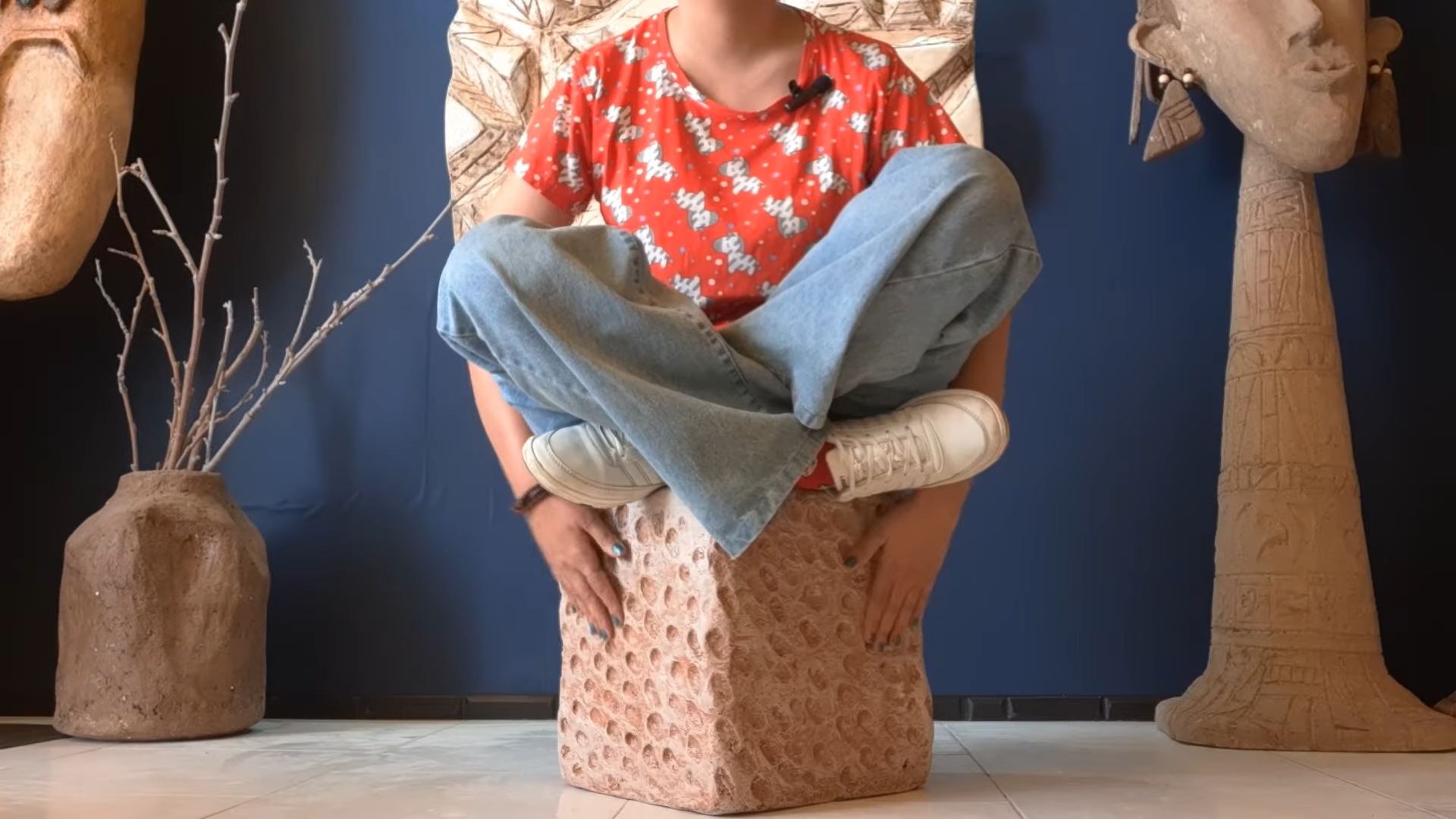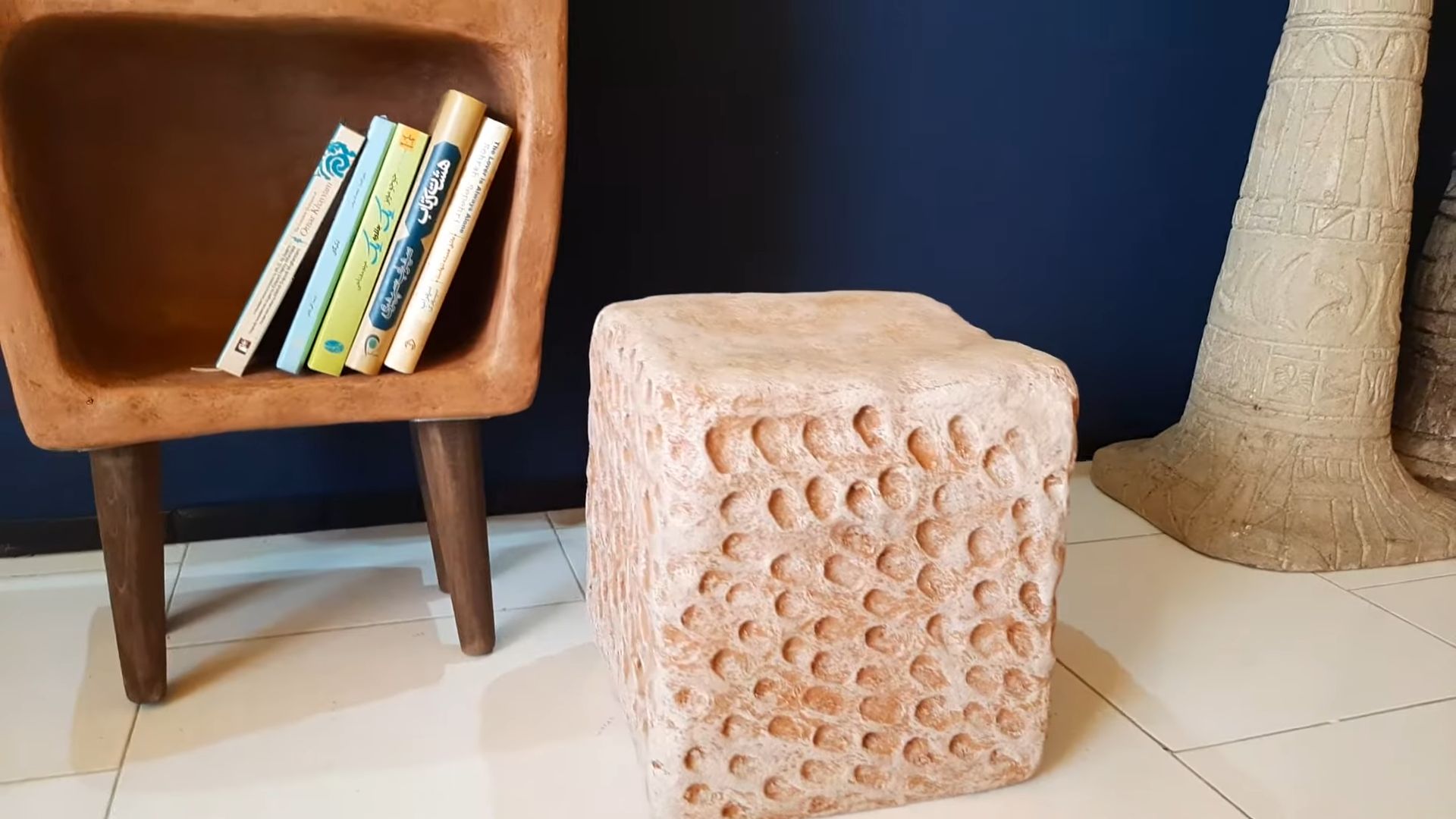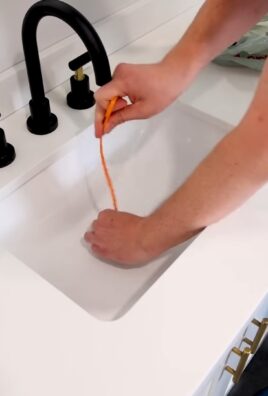DIY Eco Ottoman: Tired of staring at that pile of old tires or stacks of unused cardboard boxes in your garage? I know I was! Before you haul them off to the landfill, consider this: you can transform them into a stylish and functional piece of furniture with a little creativity and elbow grease. We’re diving into the world of upcycling to create a fantastic DIY eco ottoman!
The concept of repurposing materials isn’t new. Throughout history, resourceful individuals have found ways to give discarded items a second life. Think of the patchwork quilts born from scraps of fabric or the furniture crafted from reclaimed wood. This tradition of resourcefulness is not only economical but also deeply connected to a sense of environmental responsibility.
In today’s world, where sustainability is more important than ever, learning how to create a DIY eco ottoman is a fantastic way to reduce waste and add a unique touch to your home decor. Plus, let’s be honest, who doesn’t love a good DIY project that saves money and looks amazing? This ottoman is not only a stylish addition to any room, but it’s also a conversation starter, showcasing your commitment to eco-friendly living. So, grab your tools, gather your materials, and let’s get started on this fun and rewarding project! I promise, you’ll be amazed at what you can create with a little imagination!

DIY Eco-Friendly Ottoman from Upcycled Tires
Hey there, fellow DIY enthusiasts! Today, I’m super excited to share a project that’s not only fun and creative but also helps reduce waste: building a stylish and comfortable ottoman from old tires! This project is a fantastic way to give those discarded tires a new lease on life, turning them into a unique piece of furniture that will add a touch of rustic charm to your living space. Plus, it’s a great conversation starter!
Materials You’ll Need
Before we dive in, let’s gather all the necessary materials. Trust me, having everything ready beforehand will make the whole process much smoother.
* Two old tires (same size is ideal, but slightly different works too!)
* Thick rope (natural jute or sisal rope looks fantastic – I used about 100 feet)
* Plywood (enough to cover the top and bottom of the tires)
* Fabric of your choice (for the cushion – I went with a durable canvas)
* Foam padding (for the cushion – at least 4 inches thick for comfort)
* Staple gun and staples
* Drill and screws
* Hot glue gun and glue sticks
* Measuring tape
* Scissors or utility knife
* Sandpaper (medium grit)
* Varnish or sealant (optional, for extra protection)
* Gloves (to protect your hands)
* Safety glasses (always a good idea when working with tools!)
* Pencil or marker
Preparing the Tires
This is a crucial step, so let’s get those tires ready for their transformation!
1. Cleaning Time: First things first, give those tires a good scrub! Use soap and water to remove any dirt, grime, or debris. A pressure washer can be super helpful if you have one, but a good old-fashioned scrub brush will do the trick too. Make sure they’re completely dry before moving on.
2. Sanding the Surfaces: Use sandpaper to lightly sand the sidewalls of the tires. This will help the glue adhere better later on. You don’t need to go crazy here, just rough up the surface a bit.
3. Stacking the Tires: Place one tire on top of the other. This will form the base of your ottoman. If the tires are slightly different sizes, try to position them so the difference is less noticeable.
Creating the Top and Bottom
Now, let’s create the top and bottom supports for our ottoman.
1. Measuring the Tires: Measure the outer diameter of the tires. This will determine the size of the plywood circles you need to cut. Add an extra inch or two to the diameter for a slight overhang. This will make it easier to attach the rope later.
2. Cutting the Plywood: Using a compass or a makeshift compass (a nail, string, and pencil), draw two circles on the plywood based on your measurements. Carefully cut out the circles using a jigsaw or circular saw. Remember to wear your safety glasses!
3. Attaching the Plywood: Place one plywood circle on top of the stacked tires and the other on the bottom. Use a drill and screws to securely attach the plywood to the tires. Make sure the screws are long enough to go through the plywood and into the tire, but not so long that they poke through the other side. I recommend using at least 6-8 screws per circle for a secure hold.
Wrapping with Rope
This is where the magic happens! Get ready to transform those tires into a beautiful, textured ottoman.
1. Starting Point: Choose a starting point on the side of the ottoman. Apply a generous amount of hot glue to the tire surface and attach the end of the rope. Hold it in place until the glue sets.
2. Wrapping the Rope: Begin wrapping the rope tightly around the tires, working your way around in a spiral pattern. Apply hot glue to the tire surface every few inches to secure the rope in place. Make sure the rope is snug and there are no gaps between the rows. This is the most time-consuming part, so put on some music or a podcast and get comfortable!
3. Continuing the Spiral: Continue wrapping the rope, row by row, until you reach the top plywood circle. Make sure the rope covers the entire tire surface.
4. Finishing the Top: When you reach the top, carefully glue the end of the rope to the plywood, making sure it’s securely attached. You can tuck the end under the last row of rope for a cleaner look.
5. Repeating for the Bottom: Flip the ottoman over and repeat the rope-wrapping process on the bottom half.
6. Securing the Ends: Once you’ve finished wrapping both the top and bottom, go back and add extra glue to any areas that seem loose or insecure. This will ensure that the rope stays in place for years to come.
Creating the Cushion
Now, let’s add a comfy cushion to make our ottoman even more inviting!
1. Measuring the Top: Measure the diameter of the top plywood circle. This will determine the size of the cushion you need to make.
2. Cutting the Fabric: Cut two circles of fabric, each slightly larger than the diameter of the plywood circle (add about 2-3 inches for seam allowance).
3. Cutting the Foam: Cut a circle of foam padding to the same diameter as the plywood circle.
4. Sewing the Cushion Cover: Place the two fabric circles right sides together and sew around the perimeter, leaving a small opening for stuffing.
5. Stuffing the Cushion: Turn the fabric cover right side out and stuff it with the foam padding. Make sure the foam is evenly distributed for a comfortable cushion.
6. Closing the Opening: Fold the edges of the opening inward and sew it closed using a needle and thread or a sewing machine.
Attaching the Cushion
There are a few ways to attach the cushion to the ottoman. I prefer using Velcro for easy removal and cleaning.
1. Applying Velcro: Cut strips of Velcro and attach one side to the top of the ottoman (using hot glue or staples) and the other side to the bottom of the cushion.
2. Securing the Cushion: Press the cushion onto the ottoman, making sure the Velcro strips align.
Finishing Touches (Optional)
These steps are optional, but they can add extra protection and durability to your ottoman.
1. Applying Sealant: If you want to protect the rope from moisture and wear, you can apply a sealant or varnish. Choose a sealant that is suitable for natural fibers. Follow the manufacturer’s instructions for application.
2. Adding Feet: You can add small feet to the bottom of the ottoman to raise it slightly off the ground and protect the rope. You can find furniture feet at most hardware stores. Attach them using screws or glue.
Enjoy Your New Ottoman!
And there you have it! A beautiful, eco-friendly ottoman made from upcycled tires. I hope you enjoyed this DIY project as much as I did. Now, sit back, relax, and enjoy your new piece of furniture! Feel free to customize it with different rope colors, fabric patterns, or even paint the tires before wrapping them. The possibilities are endless! Happy crafting!

Conclusion
So, there you have it! Transforming old tires into stylish and functional ottomans is not just a craft project; it’s a statement. It’s a statement about your commitment to sustainability, your creativity, and your ability to turn something discarded into something truly desirable. This DIY eco ottoman project is more than just a way to get a new piece of furniture; it’s a chance to reduce waste, express your personal style, and impress your friends and family with your ingenuity.
Why is this a must-try? Because it’s incredibly rewarding. The satisfaction of taking a discarded tire and giving it a new life as a beautiful and useful piece of furniture is unparalleled. It’s also a fantastic way to save money. New ottomans can be expensive, but with a little time and effort, you can create a unique piece for a fraction of the cost. Plus, you’ll have a conversation starter that reflects your values.
But the benefits don’t stop there. This project is also incredibly versatile. You can customize your ottoman to perfectly match your décor. Use different fabrics, add decorative elements, and choose the perfect height to create an ottoman that is uniquely yours.
Here are a few suggestions and variations to get your creative juices flowing:
* Fabric Frenzy: Don’t limit yourself to just one fabric! Use a patchwork design with scraps of different materials for a bohemian vibe. Consider using outdoor fabrics for an ottoman that can withstand the elements on your patio.
* Leg Up: Experiment with different types of legs. Wooden legs can add a touch of elegance, while metal legs can give your ottoman a more modern look. You can even use casters for easy mobility.
* Storage Solution: Turn your ottoman into a storage unit by adding a hinged lid. This is a great way to hide blankets, pillows, or other items.
* Buttoned Up: Add tufting for a luxurious look. This involves creating indentations in the fabric and securing them with buttons.
* Rope Wrap: Instead of fabric, wrap the tire in thick rope for a nautical or rustic feel. Secure the rope with glue as you go.
* Paint it Up: Before adding fabric, paint the tire a fun color for a pop of personality.
We truly believe that anyone can tackle this project. It’s a great way to get your hands dirty, unleash your creativity, and contribute to a more sustainable future. So, gather your materials, roll up your sleeves, and get ready to transform that old tire into a stunning DIY eco ottoman.
We’re confident that you’ll love the results. But don’t just take our word for it. Try it yourself and see the magic happen. And most importantly, we want to hear about your experience! Share your photos, tips, and variations with us in the comments below. Let’s inspire each other to create beautiful and sustainable pieces for our homes. We can’t wait to see what you create!
FAQ
What kind of tire should I use?
Ideally, you should use a car tire or a small truck tire. Larger tires might be too bulky for an ottoman. Make sure the tire is clean and free of any sharp objects or debris. It’s also a good idea to check the tire for any signs of damage, such as cracks or bulges. If the tire is severely damaged, it’s best not to use it for this project. You can often find used tires at tire shops or online marketplaces.
What kind of fabric is best for covering the ottoman?
The best fabric for covering your DIY eco ottoman depends on your personal style and the intended use of the ottoman. For high-traffic areas or outdoor use, durable fabrics like canvas, denim, or outdoor upholstery fabric are good choices. For a more luxurious look, consider velvet, faux leather, or brocade. Cotton and linen are also good options, but they may require more frequent cleaning. Consider the pattern and color of the fabric as well. A bold pattern can add a pop of personality, while a neutral color can blend seamlessly with your existing décor.
How do I clean the tire before starting the project?
Cleaning the tire is an essential step to ensure a clean and hygienic finished product. Start by using a stiff brush and soapy water to remove any dirt, grime, or debris from the tire’s surface. Rinse thoroughly with water and allow the tire to dry completely before proceeding with the project. For stubborn stains or grease, you can use a degreaser or a specialized tire cleaner. Be sure to follow the manufacturer’s instructions when using these products.
How do I secure the fabric to the tire?
There are several ways to secure the fabric to the tire. The most common method is to use a staple gun. This is a quick and easy way to attach the fabric securely. However, you can also use fabric glue or a combination of both. If you’re using fabric glue, be sure to choose a strong adhesive that is suitable for use on rubber and fabric. Apply the glue evenly to the tire’s surface and then press the fabric firmly into place. You may need to use clamps or weights to hold the fabric in place while the glue dries.
How do I add legs to the ottoman?
Adding legs to your DIY eco ottoman can elevate its style and make it more functional. You can purchase pre-made legs from a hardware store or online retailer. Choose legs that are the appropriate height and style for your ottoman. To attach the legs, you’ll need to create a solid base on the underside of the tire. You can do this by attaching a piece of plywood or MDF to the tire using screws or glue. Then, attach the legs to the plywood or MDF using screws or bolts. Make sure the legs are securely attached to prevent the ottoman from wobbling.
Can I use this ottoman outdoors?
Yes, you can use this ottoman outdoors, but you’ll need to take a few precautions. First, choose a fabric that is specifically designed for outdoor use. These fabrics are typically water-resistant and fade-resistant. Second, consider adding a waterproof sealant to the tire to protect it from the elements. Finally, make sure the legs are made of a material that is suitable for outdoor use, such as treated wood or metal.
What if I don’t have a staple gun?
If you don’t have a staple gun, you can still complete this project. You can use fabric glue to attach the fabric to the tire. However, this method may take longer and require more patience. Be sure to use a strong adhesive and apply it evenly to the tire’s surface. You may also need to use clamps or weights to hold the fabric in place while the glue dries. Another option is to hand-sew the fabric to the tire. This is a more time-consuming method, but it can create a beautiful and durable finish.
How can I make the ottoman more comfortable?
To make your DIY eco ottoman more comfortable, consider adding a layer of padding under the fabric. You can use foam, batting, or even old blankets or towels. Simply cut the padding to the size of the tire and attach it to the tire using glue or staples. You can also add a cushion to the top of the ottoman for extra comfort.
Where can I find inspiration for my ottoman design?
There are many places to find inspiration for your ottoman design. You can browse online platforms like Pinterest and Instagram for ideas. You can also look through home décor magazines or visit furniture stores to see what’s trending. Don’t be afraid to experiment with different fabrics, colors, and embellishments to create a unique and personalized ottoman.
Is this project suitable for beginners?
Yes, this project is suitable for beginners. It’s a relatively simple project that doesn’t require any special skills or tools. However, it’s important to take your time and follow the instructions carefully. If you’re unsure about any of the steps, don’t hesitate to ask for help from a friend or family member. With a little patience and effort, you can create a beautiful and functional DIY eco ottoman that you’ll be proud of.





Leave a Comment